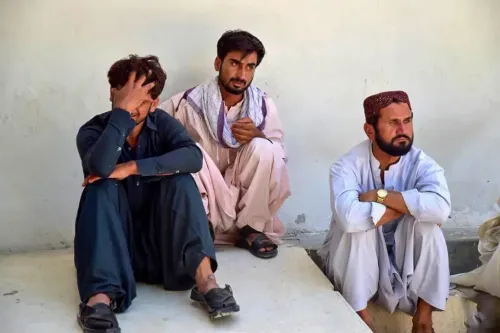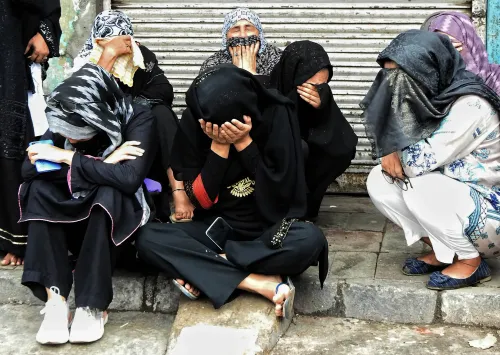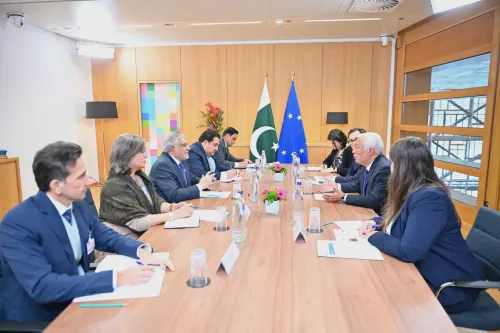The Information Machine: ISPR and Military Narrative Management in Pakistan (IANS Analysis)

Synopsis
Key Takeaways
- The ISPR plays a crucial role in controlling military narratives in Pakistan.
- It has been instrumental in shaping public perception through selective information dissemination.
- The recent hijacking incident illustrates the complexities of military-media relations.
- The ISPR employs various media strategies to promote favorable military narratives.
- Social media has emerged as a counterforce to ISPR's narrative control.
New Delhi, March 23 (NationPress) On 11th March 2025, Baloch insurgents carried out a well-planned ambush, leading to the hijacking of the Jaffar Express train in the isolated Bolan district of Balochistan, transporting 440 passengers, predominantly off-duty personnel from the Pakistan Army. This event stands out as one of the most significant acts of insurgent violence in recent times, resulting in serious casualties.
Nevertheless, an extensive information blackout followed as the incident unfolded. This suppression was enforced by Pakistan’s military establishment, via its Inter-Services Public Relations (ISPR), which tightly regulates the flow of narratives. The ISPR selectively distributed curated information through various mainstream television networks, effectively creating an informational void.
This occurrence further emphasized the influential role of the ISPR as the main channel for state-approved narrative creation, systematically influencing public perception of the military by managing the information landscape.
The Inter-Services Public Relations (ISPR) Directorate, founded in 1949, functions as the central public relations entity of the Pakistani Armed Forces. It is operated by a joint team of military officers and civilian officials, under the administrative supervision of the Joint Chiefs of Staff Secretariat (JCSS).
The Directorate is headed by the Director General (DG), previously known as the Executive Officer, who serves as the chief military spokesperson for the nation.
In 2024, the role of DG ISPR was elevated to a three-star Lieutenant General rank, previously held at the two-star level.
The DG-ISPR reports directly to the Chairman of the Joint Chiefs of Staff Committee (CJCSC) and the various service heads of the Army, Navy, and Air Force, while also providing situational updates to the Coast Guard chief and the Marine Commandant when required.
Although officially a joint military body, the ISPR has been predominantly shaped by the Pakistan Army, with a naval officer having led it only once, from 1952 to 1965, which remains one of the longest tenures in its history.
The current Director General, Lt. Gen. Ahmed Sharif Chaudhry, is the 22nd individual to serve in the role of DG ISPR and the first active Lieutenant General in this position.
He is supported by two Major General-ranked officers responsible for overseeing foreign and strategic communications and domestic media relations. Additionally, three Deputy Director Generals (DDGs) from the three branches of the armed forces supervise communication and media responsibilities related to their respective services.
In his publication, The Military and Public Relations – Issues, Strategies, and Challenges (2012), John Adache states that the ISPR serves as a vital bridge between the military, the media, and the public.
As Adache notes, its primary aim is “to garner national support for the Armed Forces” while shielding the military from adverse narratives, whether from domestic or international sources. In this capacity, through its meticulously crafted communication strategies, the ISPR acts as a central component of the state's information control and perception management framework.
For instance, the ISPR showcased its role as a crucial instrument in promoting a pro-military narrative by actively disseminating misinformation prior to the Pakistan Army's operational response to the Bolan train hijacking situation.
Pakistan's television channels, which function as media outlets under military influence, broadcast altered video footage of military helicopters, allegedly provided by the ISPR, aiming to present these as authentic visuals of the military operation.
As the military operation unfolded, the ISPR officially announced that the Pakistan Army had rescued nearly 80 hostages by the evening of 11th March. However, these assertions were contested by independent sources and survivors, who claimed that it was the BLA fighters who allowed women, children, and the elderly to pass through safely.
Furthermore, after the Army reported that the BLA had executed 21 military hostages out of over 300 captured, this narrative faced contradiction from ground reports, despite the media blackout, indicating that over a hundred military hostages had been killed by Baloch insurgents. The BLA, in turn, claimed to have executed 214 military hostages during the standoff.
Amidst the differing claims of the ISPR and the BLA, the actual number of casualties remains unclear, underscoring how the ISPR employed selective statistics to mitigate possible criticism and shape public perception, aiming to deflect accountability for significant intelligence and security shortcomings by controlling information flow.
The ISPR operates through a complex organizational framework, comprised of various divisions, each with specialized functions, including the Media Management and Public Affairs Wings, the Production and Content Creation Division, and the Monitoring and Analysis Wing, among others.
Within the Media Management and Public Affairs Wings, there exist additional subunits with specific responsibilities, such as Media Relations, which manages interactions with domestic and international media; Public Relations, which oversees official military statements and public outreach; Social Media Management, which curates and maintains the military’s digital presence; and Crisis Communication, which formulates rapid-response strategies during emergencies or operational events.
Consider the instance of the Balakot Air Strikes executed by India in 2019, which underscored the ISPR’s role in strategic narrative administration.
On 26th February 2019, when Indian Air Force (IAF) fighter jets crossed the international border to target Jaish-e-Mohammad (JeM) terrorist infrastructure deep within Pakistan, the ISPR, then under the leadership of Maj. Gen. Asif Ghafoor, aimed to mitigate the reputational repercussions of this significant airspace incursion that caught Pakistani forces off guard.
In his official briefing, the DG ISPR downplayed the event, asserting that the IAF jets had merely hit a “forested area” without causing considerable damage or loss of life.
Though the ISPR tightly controlled the information flow, local social media reports from that time revealed how authorities sanitized the area by removing dead bodies before the ISPR orchestrated a guided tour for journalists. This strategic framing demonstrated the ISPR’s adept use of information management to sway public perception, minimize domestic backlash, and control both national and international discussions surrounding this security lapse.
In addition to its significant oversight over mainstream news outlets, the ISPR employs its Production and Content Creation Division to actively generate media content, including documentaries, dramas, songs, and other military-related materials.
This includes collaborations with the entertainment sector, such as sponsoring numerous television dramas—arguably the most popular form of entertainment in Pakistan—to leverage the cultural influence of mainstream media. The objective is to cultivate a positive public perception of the armed forces by promoting favorable military narratives.
For example, consider the widely acclaimed drama Ehd-e-Wafa (Pledge of Allegiance), which aired on Hum TV, PTV Home, and the ISPR’s own platforms between 2019 and 2020. Directed by Momina Duraid, a leading media director and the creative head of the Hum TV network, the series chronicled the lives of four friends from varied social backgrounds, one of whom had a military background.
Significantly, the depiction of the military character was meticulously designed to present the Army as a symbol of moral integrity, sophistication, and social prestige.
Conversely, the narratives surrounding the other three characters and their families were filled with portrayals of moral decay, personal flaws, and socio-cultural dysfunction.
This intentional contrast underscored the Pakistan Army's view of broader society, with the ISPR playing a pivotal role in utilizing entertainment media as a tool for narrative construction—systematically enhancing the idealized image of the armed forces while reinforcing a sanitized, glorified depiction of military life.
This exemplifies how the ISPR adeptly employs a meticulously crafted information management system to assert its dominance over the national media landscape, strategically advancing its narrative-building initiatives to cultivate a favorable public image of the armed forces.
The extensive influence of this military-media complex operates with such sophistication that it necessitates advanced media literacy to fully comprehend its underlying mechanisms and objectives. However, the advent of social media has, to some extent, disrupted this hegemonic control, acting as a counterbalancing force.
Through collective digital mobilization and grassroots fact-checking, segments of the public, despite facing significant risks from the military, have increasingly questioned state-sanctioned narratives, effectively revealing the constructed nature of the military’s information system—a phenomenon reminiscent of the proverbial “unmasking of the shadowy emperor.”









